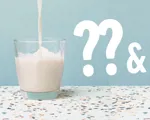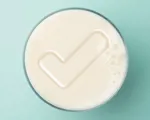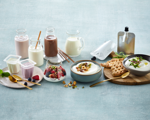
No, lactose-free is not the same as dairy-free. The two terms can be difficult to distinguish but they are not the same. So, it is time to set the record straight and define them.
Doing so will make it easier to discuss the difference between lactose-free and dairy-free foods and why the two may sometimes, but not always, overlap. Keep reading below to find out more.
The difference between lactose-free and dairy-free
To put it simply, lactose-free products have had the lactose removed or broken down, while dairy-free products are made without milk or milk derivatives altogether. For instance, lactose-free milk is a dairy product with lactose removed, while almond drink is a dairy-free product made from almonds and oat drink is a dairy-free product made from oats.
Now, back to basics. Lactose is a natural sugar found in milk, in other words, dairy. All types of mammal milk contain lactose, meaning that products such as cheese, cream, ice cream, and butter all contain varying levels of lactose. In lactose-free products, the lactose has been removed or reduced significantly. You can read more about this in our articles:
- What is lactose-free cheese?
- Does butter have lactose?
- Does cream have lactose?
- Is yoghurt lactose-free?
- Lactose-free foods
Dairy, on the other hand, refers to foods and drinks that are made from the milk of mammals such as cows, goats, sheep, and buffalo – whether the lactose has been removed or not.
As you have probably already noticed, the two definitions allow for overlap. Let us dig deeper into this potential overlap and the production of lactose-free products to get to the root of the differences.

How to make lactose-free products?
Many lactose-free products are made from lactose-free milk to which lactase has been added. Lactase is a natural enzyme that breaks down lactose into simpler sugars: glucose and galactose.
Different products are made lactose-free in different ways, though.
- For lactose-free butter, the enzyme is simply added to fresh cream rather than milk.
- For cheese and yoghurt, it is added to the dairy alongside bacterial cultures before the ageing or fermentation process is begun. The lactose cannot be removed from the milk before the cheesemaking process itself, as the bacteria need to consume and convert it into lactic acid to give the cheese its desired flavour.
- The same goes for yoghurt, as the lactic acid gives it its signature tang.
At Arla, the milk is typically run through an ultrafiltration tank before the enzymatic treatment begins. This is our preferred method, as it ensures the lowest possible amount of lactose traces and the greatest flavour. The specialised filters help preserve the recognisable flavour as hydrolysing the full amount of lactose would result in a much sweeter flavour profile.
Are lactose-free products always dairy-free?
No, lactose-free products are not dairy-free. As we have mentioned, some crafty processes allow us to indulge in dairy delights without the lactose. More specifically, these processes create lactose-free products, but they still use dairy as the base ingredient. For a product to be labeled lactose-free, it requires the product to have contained lactose at some point.
Let us take lactose-free cheddar as an example. While it has had its lactose removed, it is still made from cow’s milk, making it a dairy product. Alternatives to dairy products, however, do not have lactose, and they are not dairy either. This is, for example, milk and cheese alternatives made from oats, almonds, or soy.
Are dairy-free products always lactose-free?
Yes, dairy-free products are also lactose-free. Dairy-free means that milk does not play a part, so there is no lactose. Our examples of oat, almond, and soy alternatives are living proofs of this – no milk, no lactose.
We hope this clears the fog around these terms. Fancy exploring more on this topic? Dive into our article Is lactose-free milk dairy-free? to make it even clearer.
How to check for lactose-free or dairy-free products
Familiarising yourself with product labels is key. While many products are marked as either 'lactose-free' or 'dairy-free', 'non-dairy', or 'milk-free', it is not the case for all foodstuffs. There are regulations in place to ensure accurate labelling of food products, although these may change from one country to another.
So, it is always a good idea to read the ingredients list and any “may contain”-statements to be sure. Look for added milk and dairy products. Obvious ones include milk (of any type, including condensed, malted, powdered, and evaporated milk), cheese, buttermilk, cream, and sour cream.
But you also need to look for ingredients such as curds, whey, whey protein concentrate, milk casein, and milk by-products.
Many kinds of prepared and processed foods contain lactose and dairy – even ones you might not expect. So be sure to have a look at the label of your preferred breakfast cereals, snacks, soups, and sauces to learn more about their contents.











































